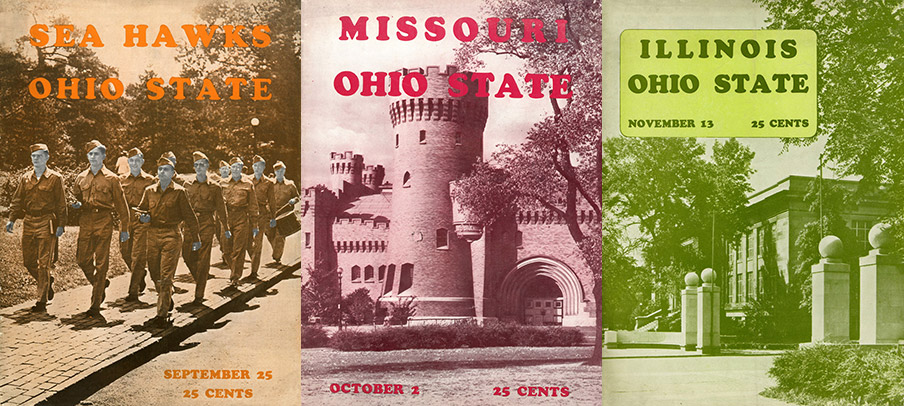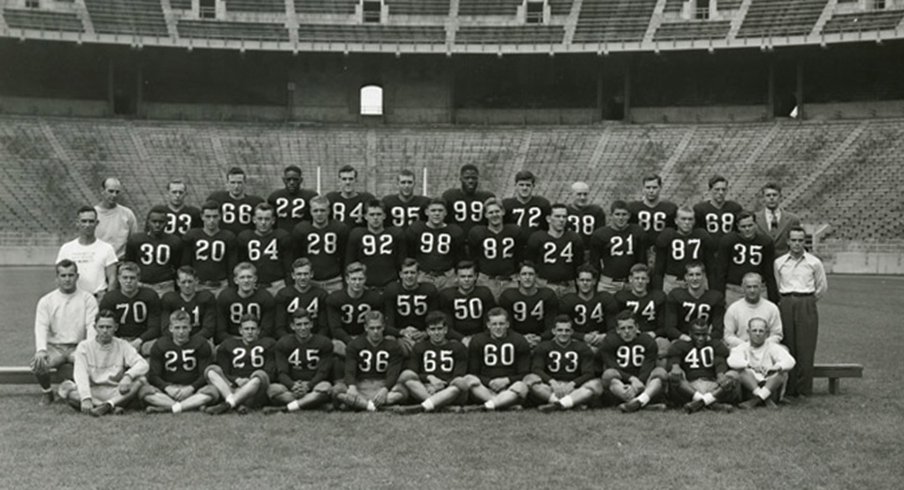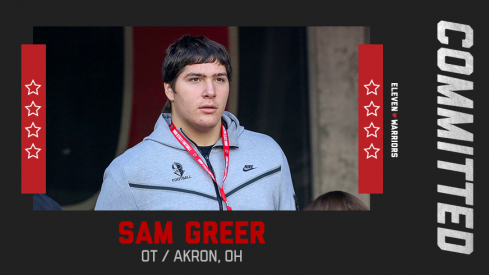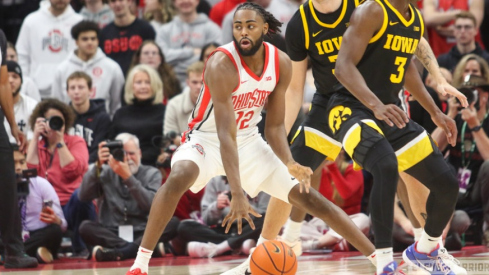Ohio State won the national championship in 1942 with a young and talented team. Typically that's the recipe for another run at a championship. 1943 was anything but typical, though.
Only five players, including a mere one starter from the '42 team, returned for the 1943 season, Paul Brown's third in Columbus as the head coach of the Buckeyes.
Tackle Bill Willis, was lone returning starter and he was on the roster because he was denied entrance into the military because of surgery he had on his varicose veins. So, why did Ohio State only have five players from the championship team on the roster in 1943?
Weird ROTC rules.
| The 1943 Buckeyes | |
|---|---|
| Record | 3–6 |
| B1G Record | 1–4, 7th |
| Coach | Paul Brown (3rd year, 18–8–1) |
| Captains | Chuck Csuri, John Dugger |
Due to the war, Ohio State football had teamed up with the Army ROTC program at the school. Unfortunately, ROTC rules mandated players involved with the ROTC program were not eligible to play varsity sports. This was a problem for the Buckeyes as many of the players were in the program.
Had Ohio State partnered with the Navy V-12 program, like Michigan, Northwestern and Purdue did, the football team would have been much deeper.
The Big Ten had a dilemma on its hands due to the disparity in doctrines. While Ohio State, Indiana and Iowa were decimated by ROTC roster rules, other programs within the league were not affected. In fact, Navy V-12 rules allowed those schools to accept transferring students able to play immediately.
The Big Ten moved to try to balance things by allowing Army ROTC schools to play freshmen, but they were they were generally no match going against other programs stacked with juniors and seniors.
This was the mountain Paul Brown was tasked with climbing in 1943.
Games of Note
September 25th • #8 Iowa Pre-Flight • Ohio Stadium
The Buckeyes entered this contest having won 49 straight opening games. However, this impressive streak was in jeopardy with the “Baby Bucks” playing the grown men of Iowa Pre-Flight.
Don Faurot, the coach of the Seahawks, was one of four finalists for the Ohio State job that was awarded to Brown prior to the 1941 season. A few months later, Faurot's Missouri Tigers were the first team Brown faced as head coach of Ohio State. The Buckeyes beat Missouri 12-7 that day.
This time, Faurot had an advantage. His team of former professional men was far superior to Brown's freshmen. The Seahawks quickly jumped out to a 28-0 lead before calling off the dogs.
Ohio State scored twice in the second half to make the game respectable, but the 28-13 final score was indicative of the disparity between the teams. After the game, Brown told Faurot, “You could have beaten us 100-0 if you had wanted.”
He then thanked Faurot for not running up the score.
Iowa Pre-Flight ended the season ranked No. 2 in the final AP Poll. The team's only loss was 14-13 to No. 1 Notre Dame in the season finale.
| DATE | OPPONENT | LOCATION | RESULT |
|---|---|---|---|
| SEP. 25 | IOWA PRE-FLIGHT | OHIO STADIUM | L, 13–28 |
| OCT. 2 | MISSOURI | OHIO STADIUM | W, 27–6 |
| OCT. 9 | #12 GREAT LAKES | ROSS FIELD | L, 6–13 |
| OCT. 16 | #5 PURDUE | CLEVELAND | L, 7–30 |
| OCT. 23 | #17 NORTHWESTERN | OHIO STADIUM | L, 0–13 |
| OCT. 30 | INDIANA | OHIO STADIUM | L, 14–20 |
| NOV. 6 | PITTSBURGH | PITT STADIUM | W, 46–6 |
| NOV. 13 | ILLINOIS | OHIO STADIUM | W, 29–26 |
| NOV. 20 | #4 MICHIGAN | MICHIGAN STADIUM | L, 7–45 |
| 3–6, 149–187 |
October 9th • #12 Great Lakes • Ross Field
After a much needed win against Missouri, the Buckeyes traveled to the Chicago area to play The Great Lakes Naval Training Center.
Like Iowa Pre-Flight, the undefeated Bluejackets of Great Lakes were grown men who were bigger, stronger and heavier than the young Buckeyes. To the surprise of everybody at Ross Field, Ohio State kept the game scoreless through the first half.
Late in the third quarter, Steve Lach of Great Lakes threw a 27-yard touchdown pass to Steve Jurwik to put his team up 7-0. On the ensuing kickoff, Dean Sensanbaugher caught the ball five-yards deep in the end zone. Instead of taking a knee, Sensanbaugher returned it an Ohio State record 103-yards to the Great Lakes 2 yard line. Unfortunately, the Buckeyes were held on downs and did not score.
Ohio State scored in the fourth quarter to make it 7-6, but the Bluejackets' Dewey Proctor put the game away with a 57-yard touchdown run. The final score: Great Lakes 13, Ohio State 6.
A year later, Brown would be on the Great Lakes sideline.
October 16th • #5 Purdue • Cleveland Municipal Stadium
This game was supposed to be held in Ohio Stadium, but the athletic department made the decision to move the contest to Cleveland Municipal Stadium because fans in the Columbus area were struggling to make it to games.
The change in venue worked. For two quarters, at least. The over-matched Buckeyes led 7-0 at halftime. Then Purdue – a Navy V-12 school – took over the game with its deeper and older roster. The Boilermakers went ham in the second half and won 30-7. This was only the second time Purdue defeated Ohio State.
The Boilermakers went on to win the Big Ten and finished No. 5 in the final AP Poll with an undefeated record.
| OPPONENT | STREAK | RECORD |
|---|---|---|
| IOWA SEAHAWKS | L1 | 1–1 |
| MISSOURI | W3 | 3–0 |
| GREAT LAKES | L1 | 0–1 |
| PURDUE | L1 | 9–2 |
| NORTHWESTERN | L1 | 13–8–1 |
| INDIANA | L1 | 15–9–3 |
| PITTSBURGH | W3 | 5–2–1 |
| WISCONSIN | L1 | 7–5–2 |
| PITTSBURGH | W4 | 6–2–1 |
| ILLINOIS | W9 | 18–12–2 |
| MICHIGAN | L1 | 11–26–3 |
October 30th • Indiana • Ohio Stadium
In late October, Ohio State welcomed Indiana, in a battle of “civilian” teams, both Army ROTC programs at the time.
The Hoosiers jumped out to a 13-0 halftime lead, but the home crowd of 25,458 urged the Buckeyes on to a valiant comeback.
Sensanbaugher scored twice in the fourth quarter to give Ohio State a 14-13 lead. Indiana's next drive ended with a field goal attempt from the Buckeyes' 26-yard line, but the kick was thwarted when Bill Willis got his big paw on the ball.
Unfortunately, Ohio State couldn't run out the clock and was forced to punt on their next possession. Indiana took advantage and quickly advanced into Buckeye territory. Then, Indiana's Hunchy Hoernschemeyer appeared to throw the game away when Bobby McQuade intercepted his pass. However, the interception did not stand because the Buckeyes were flagged for defensive holding.
Hoernschemeyer and the Hoosiers took advantage of their second life. With 32 seconds remaining, Hoernschemeyer passed to John McDonnell for the game-winning touchdown. The 20-14 victory was Indiana's first over Ohio State since 1937.
November 13th • Illinois • Ohio Stadium
In a back and forth contest, Illinois tied the game at 26 with 6:50 remaining. Neither team was able to threaten until Illinois halfback Eddie McGovern gave Ohio State a gift.
McGovern put the ball on the ground and Ohio State's, McQuade, jumped on it. With 10 seconds remaining, Ohio State had the ball on the Illini 23-yard line. The Buckeyes' next play was a pass from McQuade to Ernie Parks. The game-winning throw missed its target and fell harmlessly to the ground. The referee indicated the game was over by firing his gun and the teams left the field.
At this point the crowd began to disperse thinking the game had ended in a 26-26 tie. Everyone in the stadium had missed the head lineman, Paul Goebel, throw a flag on Illinois for being offside.
Goebel huddled his other officials to discuss what should be done. They agreed that the game could not end on a defensive penalty and the referees were tasked with explaining the situation to the two teams in their locker rooms.
The Buckeyes made the wise choice of playing the down again. With the ball moved up to the 18-yard line, Brown decided to put the game on the foot of freshman Johnny Stungis. The 17-year old's kick barely made it over the crossbar, but it was good. That would be the only kick he attempted as a Buckeye.
Ohio State won 29-26 in what's now referred to as the “fifth quarter” of this game.
Many years after the game, Illinois head coach, Ray Eliot, reflected on the fateful knock at his locker room door. "I would have never let him (the referee) in the dressing room to talk with us."
November 20th • #4 Michigan • Michigan Stadium
Ohio State entered the 40th game of the rivalry as heavy underdogs. No. 4 Michigan was a Navy-affiliated team and had its full compliment of players. This game was going to be ugly.
However, the Baby Bucks stunned the 39,139 in attendance by keeping it close at the half, trailing 13-0. Unfortunately, games consist of two halves and the Wolverines put one on the Buckeyes in the second, going on to win the game, 45-7.
From The Cleveland Plain Dealer:
Michigan had the men and Ohio State didn't have 'em. That was the whole story here today as the high-powered lend-lease Wolverines ran away with the sadly outclassed Buckeyes, 45 to 7.
Thus ended the grim season between the "haves" and "have nots" in the Big Ten, in which the "have nots," minus navy trainee material and for all their pluck and perseverance, failed to register a single upset.
The Wolverines now led the series 26–11–3.

1943 Recap
- Ohio State chose Army ROTC affiliation instead of Navy V-12 and the football team paid the price.
- The Iowa Pre-Flight Seahawks evened the series 1-1.
- Ohio State lost four consecutive games for the first time since 1922.
- Dean Sensanbaugher set an Ohio State record with a 103-yard kickoff return. He did not score.
- Purdue won its second game against Ohio State, thanks in large part to their Navy V-12 affiliation.
- Indiana ended a four-game losing streak to the Buckeyes.
- The game required “five quarters,” but Ohio State defeated Illinois for the ninth straight time.
- The Buckeyes lost to Michigan and trail the series 11–26–3.
- Bill Willis was named All-American.
- Paul Sarringhaus, Bob Shaw, Lin Houston and Chuck Csuri were selected in the NFL Draft.
1943 was a tough season, due to Army ROTC rules. Paul Brown, as good as he was as a head coach, had his hands tied with a team full of freshmen and the Buckeyes finished the season 3–6–1.
Again, from The Cleveland Plain Dealer:
Ohio, having only one regular from last year, tackle Bill Willis, and forced to rely largely on a couple of dozen freshmen, won three games in nine starts. Ordinarily, you would say it was a miserable season, but in view of what Ohio had, it was remarkable. The Buckeyes got only two really bad wallopings, from Michigan (which lost only to Notre Dame) and Purdue (unbeaten and untied).
And, once more, there will be another day.
However, there wasn't another day for Brown at Ohio State. He was still draft eligible, so he enlisted in the Navy as a lieutenant, junior grade. Brown received orders as the head coach of the Great Lakes Naval Training Center where he spent two seasons coaching the Bluejackets. After the war, Brown returned to Ohio where he became the first coach of the Cleveland Browns.
The search was on for Ohio State's 16th head coach.



